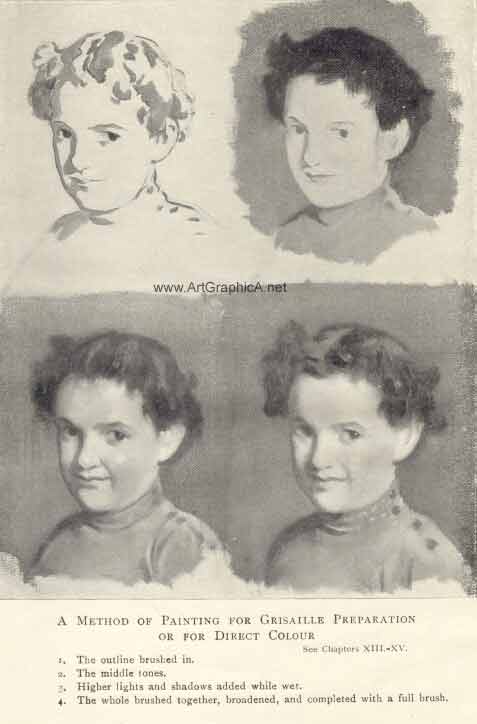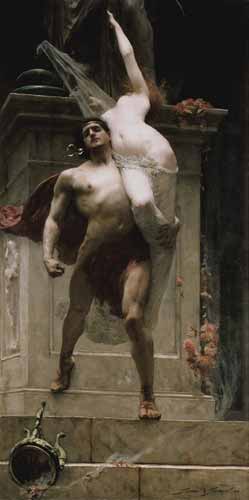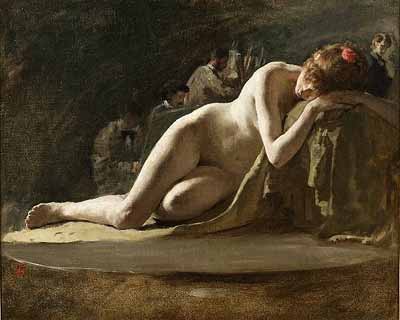THE PRACTICE OF OIL PAINTING |
||||||||||||||||
|
Page 01 / 09
AND OF DRAWING AS ASSOCIATED WITH IT BY SOLOMON J. SOLOMON, R.A.Short Introduction by ArtGraphica
It was written by the Victorian artist Solomon Joseph Solomon, who was a talented draftsman as well as painter, and who was primarily known for his mythological and biblical masterpieces. Solomon himself regretted the lack of information that has been passed on since Renaissance times, but laboured hard to pass on this gift. The book is in two parts. The former focuses on aiding the art student from drawing, into full colored paintings, explaining materials and methodologies as he goes. Solomon wasn't entirely opposed to the alla prima, impressionistic painters of his day, but preferred the more laboured approach of building up a monochromatic grisaille, before adding glazes and scumbles of semi-transparent paint. The latter half of the book deals with the methods of the Old Masters, and various European schools of art, applying the principals taught to famous works of old. *** PREFACE This book is primarily intended for the use of Art Students, but it may also be found helpful to Art Teachers who have not yet reduced their teaching to a system. I have rarely in my experience found drawing systematically taught. The master corrects the student's errors, but does not show him with sufficient clearness how he might discover them for himself, and so become in time, as he must aim at becoming, independent of assistance. 
The second part of the volume is devoted to an examination of the methods of painting used in the production of works that have stood the test of time. I hope that from what I have said on this subject the student may be able to gather material on which to base a sound and workmanlike method. This is especially necessary in these days when works of art are produced which, in my opinion, cannot possibly stand the severe test of age. The whole object of this volume is to combat the careless craftsmanship which is too common, and is detrimental to the work of any painter, however gifted.
S. J. S. PART I INTRODUCTORY [19]
I. A METHOD BY WHICH THE ROUND OBJECT CAN BE REDUCED TO THE FLAT [21] II. CONSTRUCTION OF THE FIGURE [33] III. CONSTRUCTION OF THE HEAD [43] IV. CHARACTERISATION [49] V. THE ARM HANDS AND LEGS [55] VI. LIGHT AND SHADE [59] VII. PAINTING MATERIALS COLOURS [66] VIII. MONOCHROME STUDY [81] IX. TEXTURES IN MONOCHROME [88] X. STILL LIFE IN COLOUR [91] [ix] XI. SILVER AND CHINA IN COLOUR [95] XII. HINTS ON ARRANGEMENT-SOLECISMS IN COMPOSITION [99] XIII. PAINTING FROM LIFE IN MONOCHROME [105] XIV. COLOURING A MONOCHROME [111] XV. PAINTING IN COLOUR DIRECT FROM LIFE-PREPARED AND DIRECT PAINTING COMPARED [115] PART II I. METHODS OF THE MASTERS [123] II. ITALIAN SCHOOLS [129] III. THE SCHOOL OF TITIAN [140] IV. THE ITALIAN SCHOOL-continued [157] V. THE FLEMISH SCHOOL [168] VI. THE DUTCH SCHOOL [181] VII. THE DUTCH SCHOOL-continued [190] VIII. THE SPANISH SCHOOL [204] [x] IX. THE FRENCH SCHOOL [216] X. THE BRITISH SCHOOL [219] XI. THE BRITISH SCHOOL-continued [226] XII. ON COPYING [243] XIII. ANALYSIS OF COMPOSITION [249] XIV. A FEW WORDS ON THE STUDY OF AESTHETICS [262] PART IINTRODUCTORYIN the manual which I have written with the object of aiding the Art Student in acquiring some knowledge of his craft, I have endeavoured to pass on to him some of the lessons I have received at the hands of my masters ; and to these lessons I have added the outcome of my own experience and observation, both as a worker and teacher. I am aware of the difficulty of expressing lucidly on the printed page what could be far more easily imparted by word of mouth, but I must beg the reader, after having perused the manual as a whole, to refer carefully to the instructions contained in each successive lesson, and whenever possible to practise, on the lines suggested, drawing and painting subjects similar to those given by way of demonstration, from the cast or from the living model. With this object in view I have divided the work into a series of separate lessons or chapters, beginning with a method of drawing which is not, I [20] believe, usually taught, but which my own students have found useful as an additional aid to the knowledge they had already acquired.
The next chapters are devoted to a study of tone values. It is only when the student has mastered these introductory lessons, and not till then, that I should advise him to use his palette ; for without a thorough knowledge of the human form or of form generally, and of the principles underlying the reproducing of tone (which includes a painter's modelling), no painting worthy of the name can be done with satisfaction either to the exigent student or to those to whom the painter makes his appeal. For the sake of greater clearness, I shall imagine my reader to be in the position of a pupil with whom I am conversing and whom I am teaching. He will, I trust, pardon the apparent familiarity of this method and the occasional use of colloquialisms, for I feel that it will assist him to understand more clearly the points I desire him to master.[21] Next Page: Anatomy and Oil Painting
|
||||||||||||||||
 Many artists today wish to follow the path of the old masters, yet lament the lack of knowledge passed down, or the path taught at many art schools. This book is a diamond amongst coal, and a resource to be referred to time and time again.
Many artists today wish to follow the path of the old masters, yet lament the lack of knowledge passed down, or the path taught at many art schools. This book is a diamond amongst coal, and a resource to be referred to time and time again. The lover of pictures who has had no technical[vii]training may also be helped by a perusal of this second part to discover for himself some of those qualities in a picture that are most attractive to a painter. No one can be said to understand a painting who is ignorant of the principles on which it is executed. The average painter's interest is centred, perhaps too exclusively, in its technique, and many a picture would have little charm for him if it were not for the surface qualities it displays. But some of this special enjoyment may be shared by the amateur if he will take the pains to examine pictures hi the same way as the professional artist. I hope that not these chapters only, but also the preceding lessons in practical painting and drawing, may awaken a new interest by enabling the amateur and picture-lover to gain some insight into the mysteries of the craft, and some understanding of the purely technical means of expression employed by the painter.
The lover of pictures who has had no technical[vii]training may also be helped by a perusal of this second part to discover for himself some of those qualities in a picture that are most attractive to a painter. No one can be said to understand a painting who is ignorant of the principles on which it is executed. The average painter's interest is centred, perhaps too exclusively, in its technique, and many a picture would have little charm for him if it were not for the surface qualities it displays. But some of this special enjoyment may be shared by the amateur if he will take the pains to examine pictures hi the same way as the professional artist. I hope that not these chapters only, but also the preceding lessons in practical painting and drawing, may awaken a new interest by enabling the amateur and picture-lover to gain some insight into the mysteries of the craft, and some understanding of the purely technical means of expression employed by the painter. I have then dealt with the points which I hope may be of some service in assisting the student to construct the human figure, and have endeavoured to draw his attention to Principles by which he may more readily grasp the subtleties of detailed form.
I have then dealt with the points which I hope may be of some service in assisting the student to construct the human figure, and have endeavoured to draw his attention to Principles by which he may more readily grasp the subtleties of detailed form.






